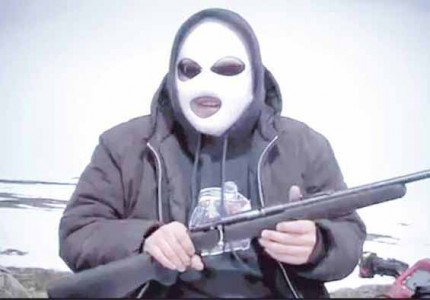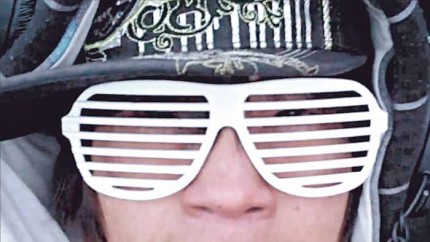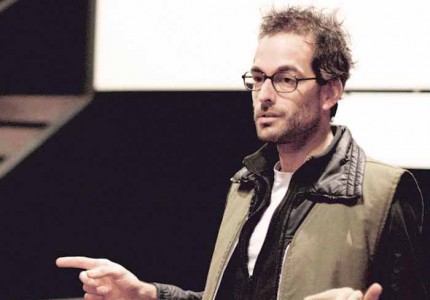“Everything you need to know is in the first scene he picked, the scene with the nude Inuit girl sitting on the white man’s leg,” said an angry viewer as she left a theatre at the Université du Québec à Montréal in disgust half-way through a festival film screening. “He’s chosen only the footage that makes Inuit look like animals. It’s disgusting.”
The object of her disgust was Dominic Gagnon’s film, of the North, which is composed entirely of amateur video segments found on the Internet, including YouTube and pornographic sites. Having previously screened the film, I was sitting in the lobby as other audience members walked out during the second of two showings at the Montreal International Documentary Festival Nov. 12-22. Across from me sat festival publicist Caroline Rompré, who was surprised by the sudden uproar and media interest as prominent Inuit figures denounced the work as racist and for failing to secure rights to the footage it used.
of the North is 74 minutes long and has no narrative, no narrator nor any identifiable structure. It was financed in part from a $32,000 grant from the Conseil des Arts et Lettres du Québec.
“A real-life Eskimo”
of the North begins with footage of a polar bear in a zoo tank smashing the tank glass. Soon after is the scene – lifted from a porn site – in which a nude Inuk woman sits on the knee of a white man. “I’m here with a truly adorable, real-life, goodness-to-gracious Eskimo!” says the man. “Tell me what it’s like being an Eskimo, growing up in Alaska?”
“It’s nothing different, other than, like, any other race,” she shrugs.
The film cuts to a drunken, apologetic Inuk man who has crashed an all-terrain vehicle. Then there are images of hunting, buildings on fire in various communities, all with traditional drumming and singing dubbed overtop.

There are a handful of scenes depicting everyday activities: people spending time with their children, walking out on the land, interacting with animals, joking in a government office. But there is a great deal of footage of drunk, and violent Inuit people. A man covered in vomit falls over as he attempts to put on his shoes. A man stalks and beats a baby seal with his hands. A camera depicts husky carcasses in a dump. A drunken man attempts to drive a ski-doo over a snowbank, flips off of it, lands on his back, tries to get on the ski-doo again, then stumbles and falls into a puddle of water.
Gagnon uses traditional throat-singing as a soundtrack to a montage of scenes of a liquor still, a group of men watching orcas breeching from a boat, and a screaming drunk man throwing rocks at a police vehicle. This cuts to a 40-second pornographic clip of an Inuk woman spreading her vagina, followed by an image of a dog’s anus.
Most northerners would find the hunting scenes unremarkable, but they seem positioned to shock southern audiences by Gagnon’s editing choices. He cuts from a group hunters butchering a whale immediately to a drunk Inuk throwing up into a toilet, his friend with the camera saying, “Aw, that’s nasty.”
Throughout there is footage of industrial machinery and development, and supporters of the film have argued this is intended to show that Inuit drunkenness and chaos are the product of industrial colonialism in the north. A scene of caribou eating raw sewage is apparently intended to make this point as well. In some cases, there is footage of children playing – in one case jumping on discarded mattresses, in another jumping on a trampoline while huskies howl all around them. At the end there is a title card reading of the North.
The filmmaker
During the question-and-answer period with Dominic Gagnon following the film, publicist Caroline Rompré and festival executive director Mara Gourd-Mercado demanded I turn off my voice recorder, saying I did not have permission to record the Q&A, though I was allowed to take notes. “We believe in free speech,” said Rompré.
The first questioner asked if Gagnon could “have made this film without using footage of drunk Inuit?” Gagnon refused to answer the question.
The session alternated between hostile questions to audience members who couldn’t understand why the film was so controversial. Media educator Jessie Curell, who has worked with Inuit and other Indigenous students in various northern communities, described the film as “a legal and ethical catastrophe,” and asked Gagnon whether the people who had appeared in the film knew they were in it.
Gagnon responded flippantly, “Everyone will know because you will tell them.”
In response to other questions, Gagnon revealed he has never travelled to the Arctic, saying he didn’t need to visit the region to understand it. “It’s a fantasy… the point is to provoke,” he said.
On the issue of rights to the footage and music used in the film, Gagnon was unrepentant. “I refuse to make a consensual film,” he said. “I’m a punk and I don’t like being told what to put in. I have the right to use what’s already public and republish it.”
He then apologized if he wasn’t making perfect sense, explaining he was drunk.
During the Q&A session, the National Film Board’s director of French programming, Colette Loumède, stood up and said, “I thought this film was beautiful. I don’t understand the outrage. We don’t have to fall into a moral judgement about it.”
When the Nation attempted to reach Loumède at the NFB for an explanation, we were told she would make no further comment.
The Nation sat down with Dominic Gagnon following the Q&A session.
“I picked up everything I could find on the Arctic that was, let’s say, homemade,” Gagnon said. “And then I ended up having 500 hours of footage. I proceeded by subtraction, like a sculptor. It’s like getting the sugar out of the fruit, making alcohol. Of course the piece is extreme. But it’s not my imagination – I didn’t stage anything, I didn’t force anything. Even YouTube and Google were helping me in my search, because they know my profile, they know what I like. It was like a ghost collaborator. I ended up picking up this footage like you go fish or go hunt.”
Gagnon admitted he had no previous knowledge of the North, nor any knowledge of Inuit culture. “I saw a film called Nanook of the North. Nothing else: that’s the only idea I have of the North.”
Asked if he was familiar with stereotypes about Inuit, he responded by asking what the difference was between stereotypes and facts. I said that stereotypes were widely believed, but were not factually correct.
“So I don’t know any stereotypes about Inuits,” he said.
Iqaluit filmmaker Alethea Arnaquq-Baril had, earlier in the day, said she was upset that the film tipped heavily toward images portraying Inuit who were drunk, violent, neglectful, cruel to animals, and self-destructive. Gagnon was asked for a reaction.
“She’s totally right,” he answered. “One of the things I said tonight is that I have the right to make a precise film. I wanted to make a film specifically about those people who have that kind of life – the drunks, those who neglect their children.”
When told that watching his film with so many images underlining commonly held prejudices against the Inuit felt like white-supremacist propaganda, Gagnon was quick to counter.
“I think you’re f*cked up,” he retorted. “I’ve seen, in my film, lots of light – people taking care of their children, entertaining them, having love for them.”
Of the intoxicated people, Gagnon said he has a great deal of compassion for them.
“I’m sorry, but I’m a drunk, I’m a toxicomane [drug addict], I have no prejudice about how they live right now. They have the right to have fun a little bit, even if they’re drunks and sociopaths. Half the people here already were drunk or under the influence of drugs. So who are we to judge them?”
Isn’t it different, I suggested, when you’re making a film about one of the most marginalized and vulnerable populations in Canada?
“Let’s give them a break,” he said. “They can have fun hunting and fishing and they can get drunk, and I don’t care about it. At least there’s one film that portrayed that. I showed it to Kanaki people in New Caledonia and they recognized themselves in it. Do you think they were crying? They were partying, they were smoking big joints like hell, drinking kava and whiskey and dancing to the music, saying, ‘Those are our bros.’”
Asked whether those who hated Indigenous people would see their prejudices supported by his film, Gagnon responded, “I don’t work for [right-wing media] and they will never see my films. But if they saw it, they would be jealous of their lives – hunting, fishing, drinking with friends. Most people are alone. They don’t know shit about what their lives are about. Those guys are a cultural avant-garde, and I have full respect for them.”
The response
A recording of this interview was later played for Inuk singer Kelly Amaujaq Fraser during a discussion of the film on CKUT-FM’s Native Solidarity News.
“That was one of the most racist conversations I’ve ever heard,” Fraser responded. “For someone to say that politicians are jealous of Inuit who are suffering from poverty, effects of colonization, lack of infrastructure for employment? I don’t think any politicians are jealous of Inuit living in these terrible conditions, and budgets keep getting cut. This video is a poor representation of what is really going on.”
Fraser’s songs and images appear in the video. She claims that, contrary to Gagnon’s contention, he never contacted her for permission.
During the same program, Inuk filmmaker Stephen Agluvak Puskas said the film disgusted him. “I felt physically sick watching it,” Puskas said. “This is what people think of me and my family?”
“I understand we still have struggles in our communities – directly caused by assimilation, from the government, from colonization,” said Fraser. “For someone to use every video he can to make Inuit look stereotypical, and showing it when Inuit have not consented, is ridiculous. This is a terrible film. It has no originality. I was very injured when I saw it. Seeing my work in there was truly upsetting.”
William Tagoona is a singer/songwriter and broadcaster in Kuujjuak, where he also works as a communications officer for the Makivik Corporation (though his comments here are his personal ones). “As a residential school survivor I am sickened by the film,” he commented. “For the whole 74 minutes I was red-faced – not from anger, but from feeling victimized. The film producer was defiantly raging his hatred on Inuit by purposely finding any trash he can find on YouTube and decorating it with some peaceful images to try and colour the true intent of the film.”
Tagoona urged Indigenous people to take the film as a warning about uploading footage of themselves to YouTube.
“It is public domain,” he said, “and there are people out there who will find ways you never imagined to utilize it to their benefit.”
The loudest critic of the film was Cambridge Bay’s Polaris-prize winner Tanya Tagaq, whose music also appeared in the film without her permission. (During the Q&A, Gagnon acknowledged that he had already heard from Tagaq and she was “going tantrum” at him. He has since agreed to remove her music.)
“You spend your life living in a shroud of racism due to post-colonial fallout, and some white piece of shit makes a film highlighting all the things that hurt you, your whole life as a child – and you try to think this is something like art? I’ve lost friends and family to alcohol. I grew up seeing so many people hurting. So many of us overcome and live amazing sober lives, but addiction comes from trauma, and just to be poking fun at that is so unnerving,” said Tagaq.
Tagaq said Gagnon’s focus represents a tiny portion of life in Inuit communities.
“There are so many beautiful, wonderful, open people working toward survival and filtering the last couple of hundred years of pain, and curing it, through our love for our children, our love of the land,” she explained. “We have been so abused by the Canadian government and we’re having massive issues with missing and murdered Indigenous women and disproportionate rates of suicide. So for some festival to feel they have the right to play this stupid film… it’s just reprehensible and I’m not happy with them. They should treat people with respect.”

The festival
For their part, festival representatives – executive director Gourd-Mercado, artistic director Charlotte Selb, and board president Sarah Spring – defended their choice to screen Gagnon’s film during a meeting with the Nation a week after the controversy erupted.
“We can’t be naïve that we’re in Canada, and it’s different to present this film here than to present it in Denmark or New Caledonia, where it was shown before,” Selb acknowledged. “We should have been more careful on that level. Should we not have programmed the film? Should we have accompanied it differently? We’re still in the process of considering that, because we want to take into consideration all the responses we’ve received. It’s our duty to figure out what we did wrong, to accept responsibility, and to correct what we need to correct.”
When she first viewed the film last April, Selb said she saw it as an interesting discourse on colonialism and its effects in the North. “It has a certain vision of very hard desperation in that life, that is the product of colonialism both in the past and in the present.”
Gourd-Mercado added that she had felt the film “really questioned the image of the Inuit themselves and what they post online, and what we see online. I thought it was a double-take on the issue of how you portray yourself on the Internet.”
Both, however, admitted that there was no discussion of the possibility that the film might be seen as racist. Their team does not contain any Indigenous members, and there were no Indigenous members of the film-competition jury assessing Gagnon’s film. Furthermore, the festival did not attempt to consult with any organization representing Inuit specifically or Indigenous people generally before showing the film.
Throughout the conversation, Gourd-Mercado and Selb underlined that they wished to take responsibility for the manner in which the film was presented. Noting that part of the French name of the festival is “Encounters” (Rencontres Internationales du Documentaire de Montréal), they said they felt that making a place for discussion, exchanges and questioning was important, particularly with difficult films.
Gourd-Mercado denied that racial prejudice played a part in the film’s selection.
“There’s a difference between a bias against Indigenous people and a poor choice,” she said. “They’re not at all the same. It’s too easy to immediately throw the festival and everything it’s accomplished out the window because of one error.”
Aftermath
The festival later issued a press release responding to “numerous complaints” about of the North. The statement read, in part, “Far from seeing of the North as a racist work, it was programmed as a critical discourse on colonialism and its still devastating impacts, through a montage of images recorded and uploaded to YouTube by Inuit peoples. We believe that this film confronts stereotypes that have afflicted Inuit peoples.”
To many discussing the issue online, this appeared to be an endorsement of the film and a defense of its imagery against charges of racism.
“Non-apology and no action,” said Iqaluit’s Jessie Aputi Fraser. “Providing more ‘context’ wouldn’t have made this film less racist or hurtful to Inuit. The film does not ‘confront’ stereotypes, it reinforces them.”





